

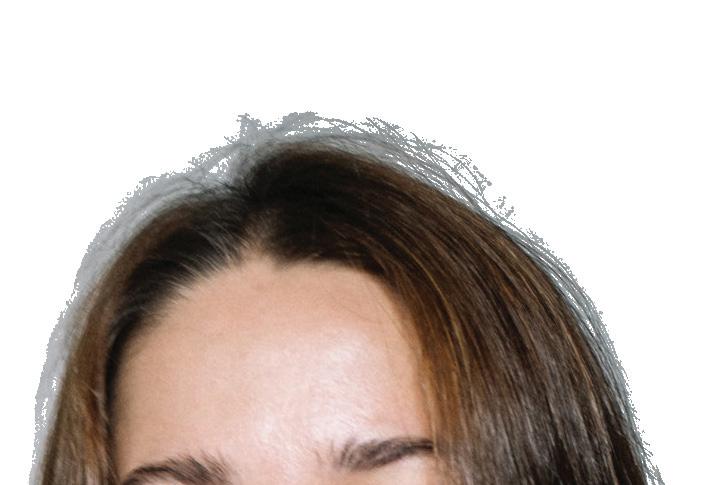




Early detection is your best defense against breast cancer,and that’swhy scheduling your annual mammogram is so important.
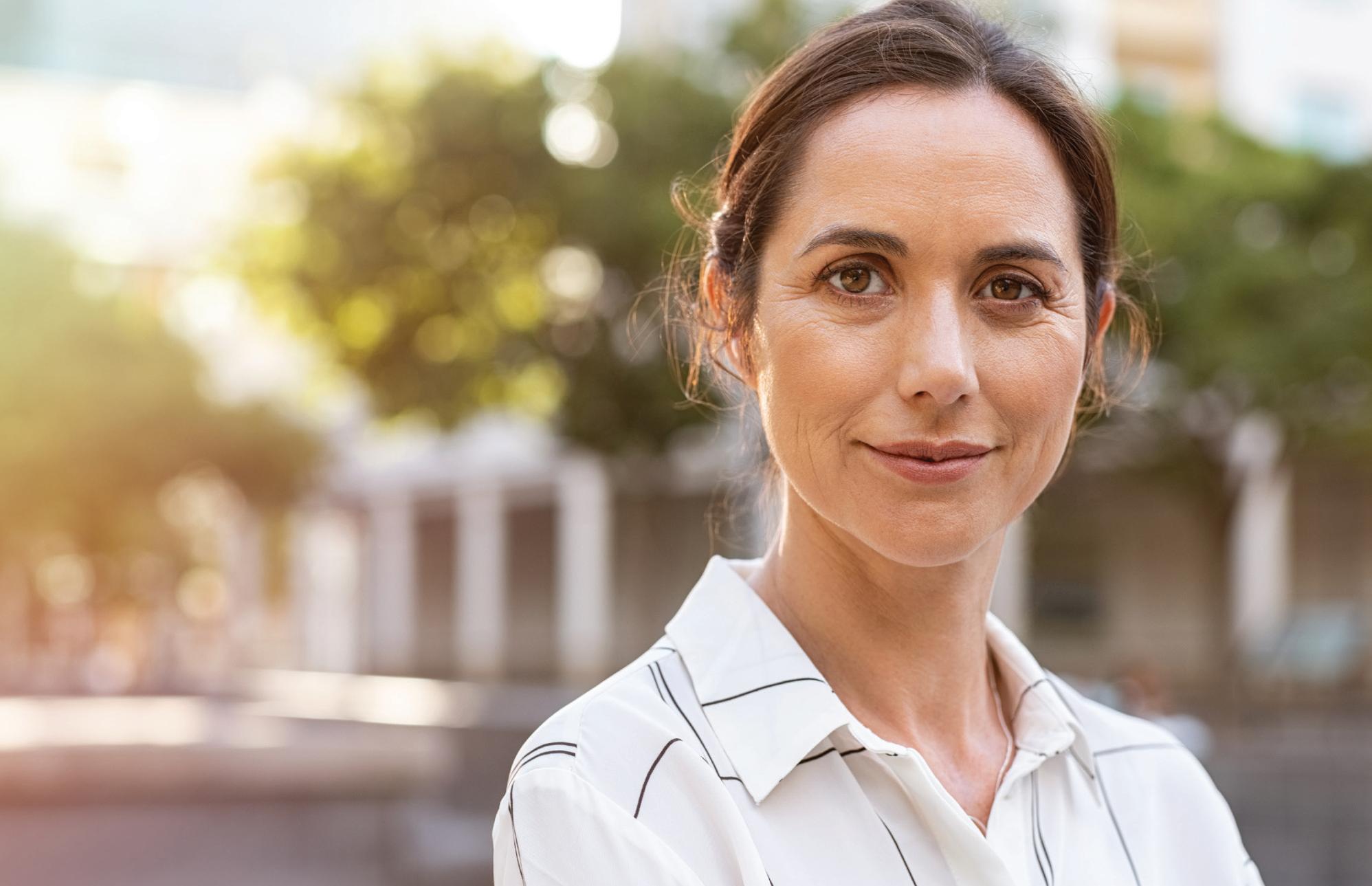
Schedule your appointment todayatthe Saint Francis Hospital Muskogee Breast Center located at 101South Rockefeller Drive, Suite101.Weoffer advanced 3D digital mammographyand ultrasound services so youcan getthe screenings youneed, closer to home.
Saint Francis Hospital Muskogee BreastCenter XavierBuilding 101S.RockefellerDr.,Suite101 Muskogee, Oklahoma74401 918-494-6900
To learn more, visit saintfrancis.com/breastservices or call 918-494-6900. Appointments can also be scheduled online through your Saint Francis MyChartaccount.
101South Rockefeller Drive, Suite101 Muskogee, Oklahoma
saintfrancis.com/breastservices

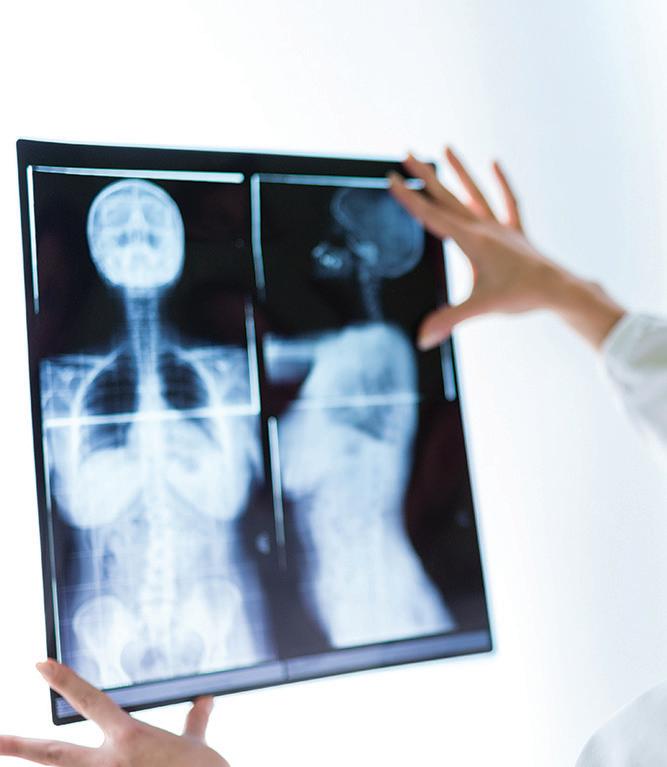








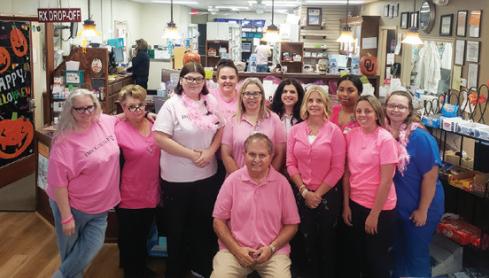


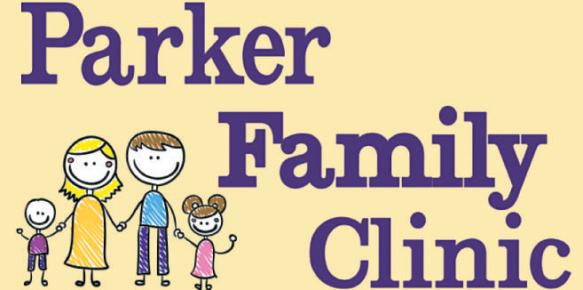


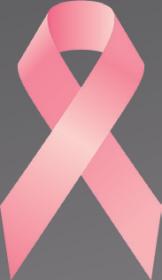

Mel's Diner owner Melissa Bales experiences all sorts of emotions as she deals with Stage III breast cancer. She said her family, employees and customers help her cope.


Restaurant
Their real concern was that it was already in my lymph nodes."
In August, Bales was diagnosed with Stage III breast cancer.
Bales, 54, had pulled through other challenges, including a house fire and major auto accident. She opened Mel's Diner in 2020, eight days before the COVID-19 pandemic hit, and kept it going it through the past two years.
Breast cancer is a new challenge altogether.

"I went to the doctor by myself, no alarms, not thinking anything would come out of my mam mogram," she said, recalling she had a clear mam mogram a year earlier.
This time, Bales told them about a lump she had found in her left breast.
"They did an ultrasound immediately," she said. "And then they found four other lumps.
She said that, after her 2021 mammogram showed no problems, she didn't do monthly breast self examinations for a while.
After feeling what she thought were underwire bra problems, she felt a lump about an inch and a half thick in her left breast. June 13, Bales went to Cherokee Nation Three Rivers Health Center.
"When they found something not normal, they
owner Melissa Bales recalls how con fident she felt before getting a mammogram on June 13.
said, 'Can you stay here? We need to get an ultrasound.' Next thing I knew I was being referred to the Warren Clinic in Tulsa," she said.
Then came the diagnosis.
"I really didn't expect to hear cancer," she said. "I just thought it was a lump, it would be benign. They'd take it out and everything would be good."
Doctors first considered doing a lumpec tomy, she said.

"But because of the size of the cancer and it being in my lymph nodes, they're going to try to shrink it first, and kill the rest of it for it not to go into the rest of my body," she said, adding that the cancer remains limited to the breast and arm area.
In the few weeks since her diagnosis, Bales underwent surgery to put a chemo port by her breasts. She began weekly five-hour che motherapy sessions a few days later, on Sept. 14.
"The surgery went well. The chemo, I felt OK. I came to work both days," she said. "Thursday I was good, and Friday I was just sick to my stomach. I'm very fatigued more easily."
She said she worries about what's to come.
"I just had one treatment and I feel horrible," she said. "The different things I know that's coming."
Bales said she's fortunate to have tribal health care. Treatments could run up to $900,000.
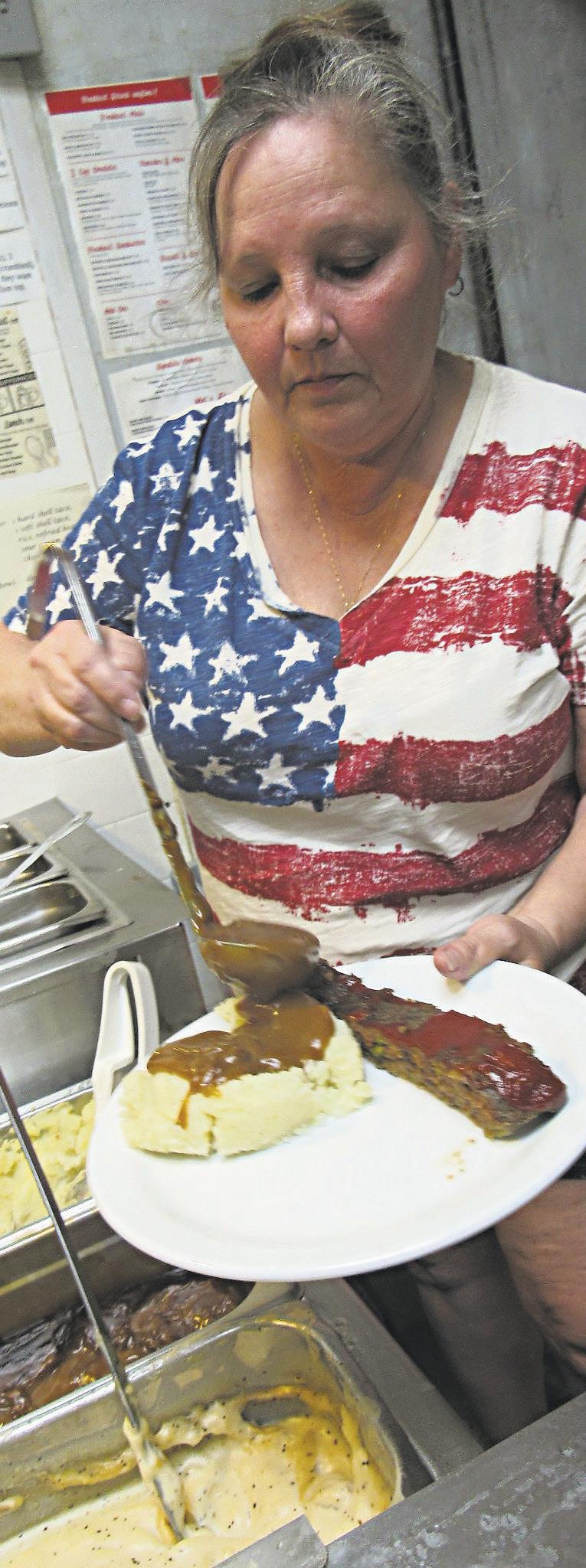




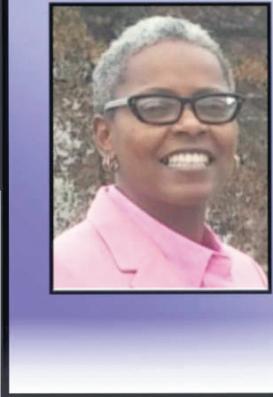


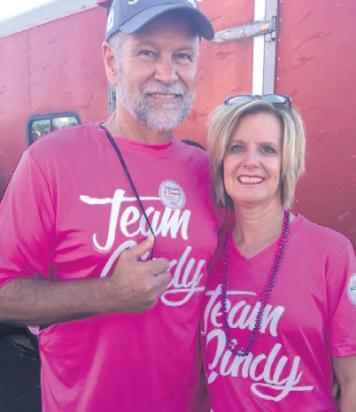



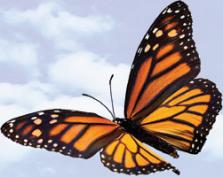

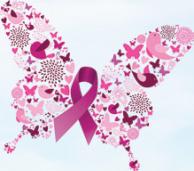


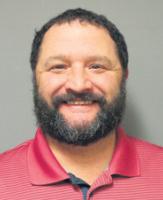



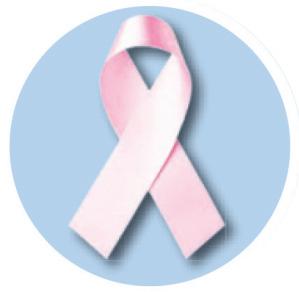


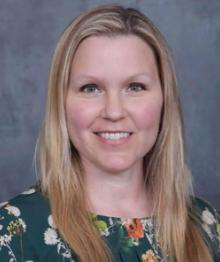
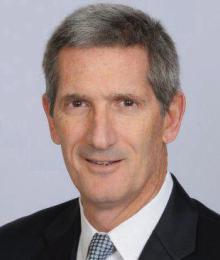
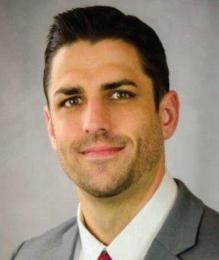


"It's scary," she said, citing all sorts of emotions and concerns. "When this is gone, possibilities of it coming back."
In the meantime, Bales comes to the restaurant for long as she physically can.
"Normally, I would be here in the early hours of the morning until 9 or 10 o'clock at night," she said. "Now, I might stay for a few hours, go home, rest, then come back when it's closing time."
Family, employees and customers remain on her mind and in her heart.

"Knowing this affects me and my family, it also affects the restaurant," she said. "And I just want everybody to be patient and kind and under
standing that if things aren't quite what someone feels they need to be, we're all going through this with me."
Bales said her daughter Brittany and her family are selling their home to move in with her. Another daughter, Kaylee, already lives with her.

"This isn't going to be just a quick fix," Bales said.
What about Bales' 5-year-old grandson, Asher? "He knows that I'm sick, and that the doctors are going to make me better," she said.
The diner's 15 employees have taken on differ ent new roles, filling in for Bales.
"A lot of the people who work here are related to me," she said. "And even the ones that aren't
Ms.Garza received her degreeasaFamily Nurse Practitioner from the Universityof Ok lahoma in 2015 and is certified by the American AcademyofNurse Practitioners with afocus in women’s health.











Ms.Garza specializes in family practiceand has experienceinurology and gynecology. She has practiced in both the private and public sectors in Muskogee and the surrounding communities



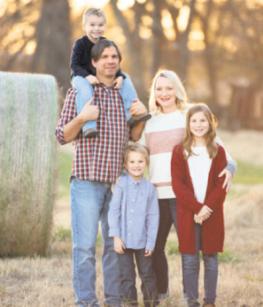

Ms.Garza has atrue passion forwellness and centers her patientcarearound health promotion and disease prevention.

my blood relation, they all love and care about this place, and me."
Customers are like family, offering an outpour ing of spiritual and emotional support, she said.


"It is just a warm feeling, that people have grown to care so much," she said. "I have a lot of love, my family friends, patrons, the doctors, the staff. I am so blessed to have what I have. I know I am not going to go through this by myself. I have that to give me strength."
Doctors and medical staff also have shown immense care, she said. "They take their time to explain things where your average person can understand."
Bales said belief in God is a huge part of her existence.
"The Lord has blessed me. I'm already cured," she said. "It's just up to the doctors to get it out of my body."


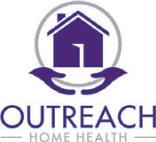





The effects of cancer on the body are profound, which is why so many people want to implement as many measures as they can to reduce their risk of developing the disease. One of the vital steps to take is to increase physical activity.
A recent study from researchers at the American Cancer Society and the National Cancer
Institute links exercise to a lower risk of specific types of cancer. People understand that exercise is important to health, but they may not know just how integral physical activity can be to cancer prevention and even recovery.
Physical activity includes walking, dancing, running, biking, swimming, engaging in sports activities, and performing household chores. The National Cancer Institute says higher levels of physical activity lower cancer risk in these types of cancer.

• Bladder cancer
• Breast cancer
• Colon cancer
• Endometrial cancer
• Esophageal cancer
• Kidney cancer
• Gastric (stomach) cancer
There also is some evidence that sug gests physical activity is associated with a reduced risk of lung cancer.

Exercise affects various biological factors, which is why it may help prevent cancer. For example, exercise can prevent high blood levels of insulin, which have been linked to breast and colon cancer progression. Furthermore, exercise can lower sex hormones like estrogen, which has been associated with cancer develop ment and progression. Since overweight and obesity are major risk factors for cancer development, exercising can re duce overall weight and belly fat, which improves the odds of cancer avoidance. Chronic inflammation is associated with the development of cancer, and exercise helps lower this harmful type of inflammation, too, says Partner MD. In ad dition, physical activity helps boost the immune system, which may help prevent cancer or assist in recovery.
The ACS says adults should get at least 150 minutes of moderate-intensity or 75 minutes of vigorous-intensity physical activity each week, preferably spread throughout the week. For those who haven’t exercised in a while, it is best to start exercising slowly and build up gradually. Examples of moderateintensity exercise include brisk walking, dancing, softball, and doubles tennis. Vigorous activities include swimming, aerobic dance, running, or jogging.
Exercise also is great for cancer sur vivors, as it can improve sleep quality and energy levels. It also helps the body repair itself, and may improve bone strength.
In addition to healthy eating, exercise is one of the key steps people can take to reduce cancer risk.
Individuals diagnosed with cancer face several hurdles in their quest to overcome their disease. The first is dealing with the shock of the diagnosis. The second is coping with treatment, which can wreak havoc on the body for several months. Making it through treatment successfully can provide a sigh of relief. But there’s often looming concerns about recurrence.

The American Cancer Society says recurrence describes cancers coming back after treatment. The odds of cancer recurring depend on several fac tors, including which type of cancer a person has had. Furthermore, there are different categories of recurrence. According to MassiveBio, a central hub that connects cancer patients to the best treatments and clinical trials available, the types of cancer recurrence patients may encounter include: local, regional and distant. Local recurrence is when the cancer is back in the same spot. Regional recurrence happens when cancer recurs in the lymph nodes near the original tumor location. Distant recurrence refers to cancer that has spread to a different location in the body and is labeled “metastatic.” For example, colon cancer that is later detected in the lungs would be called metastatic colon cancer.
Cancer Therapy Advisor says some cancers are particularly challenging to treat and have high rates of recurrence. Glioblastoma, the most common type of brain cancer, recurs in nearly all patients. Epithelial ovarian cancer recurrence also is high at 85 percent. Approximately 30 to 50 percent of patients with bladder cancer who have undergone cystectomy will experience a recurrence. Those with breast cancer who have had a lumpectomy and radiation therapy have a 3 to 15 percent risk of local recurrence within 10 years, according to Susan G. Komen. Other types of cancer with elevated recur rence rates include lung cancer, pancreatic cancer, lymphoma, and prostate cancer.
Cancer recurrence remains a possibility even after successful treatment. Physicians will schedule regular appointments following treatment to look

for any signs of recurrence so they can catch them as early as possible.
The National Cancer Institute says recurrent can cer begins with cancer cells that the first treatment didn’t fully remove or destroy. In such instances, a small number of cancer cells survived and were too small to detect on any follow-up tests. Over time, these cells grew into tumors that are now detectable. Rest assured that a recurrence is not a sign that treatment was faulty or that the oncologist did anything wrong. Some cancer cells simply survive treatment.
There’s no surefire way to prevent a recurrence. Eating better, avoiding cancer risk factors, exercising, and limiting stress are good for the body, but these behaviors do not prevent recurrence. Accord ing to the American Cancer Society, there is no guarantee cancer will never come back.
Breast cancer is the most commonly occur ring cancer in women across the globe. Ac cording to the World Cancer Research Fund International, there more than 2.26 million new cases of breast cancer in women in 2020. Such figures are sobering, but it’s important to recognize that breast cancer survival rates have improved dramatically in recent decades, providing hope to the millions of women who may be diagnosed with the disease in the years to come.
Various factors have helped to improve breast cancer survival rates, and education about the disease is certainly among them. Women are their own greatest allies against breast cancer, and learning to spot its signs and symptoms is a great first step in the fight
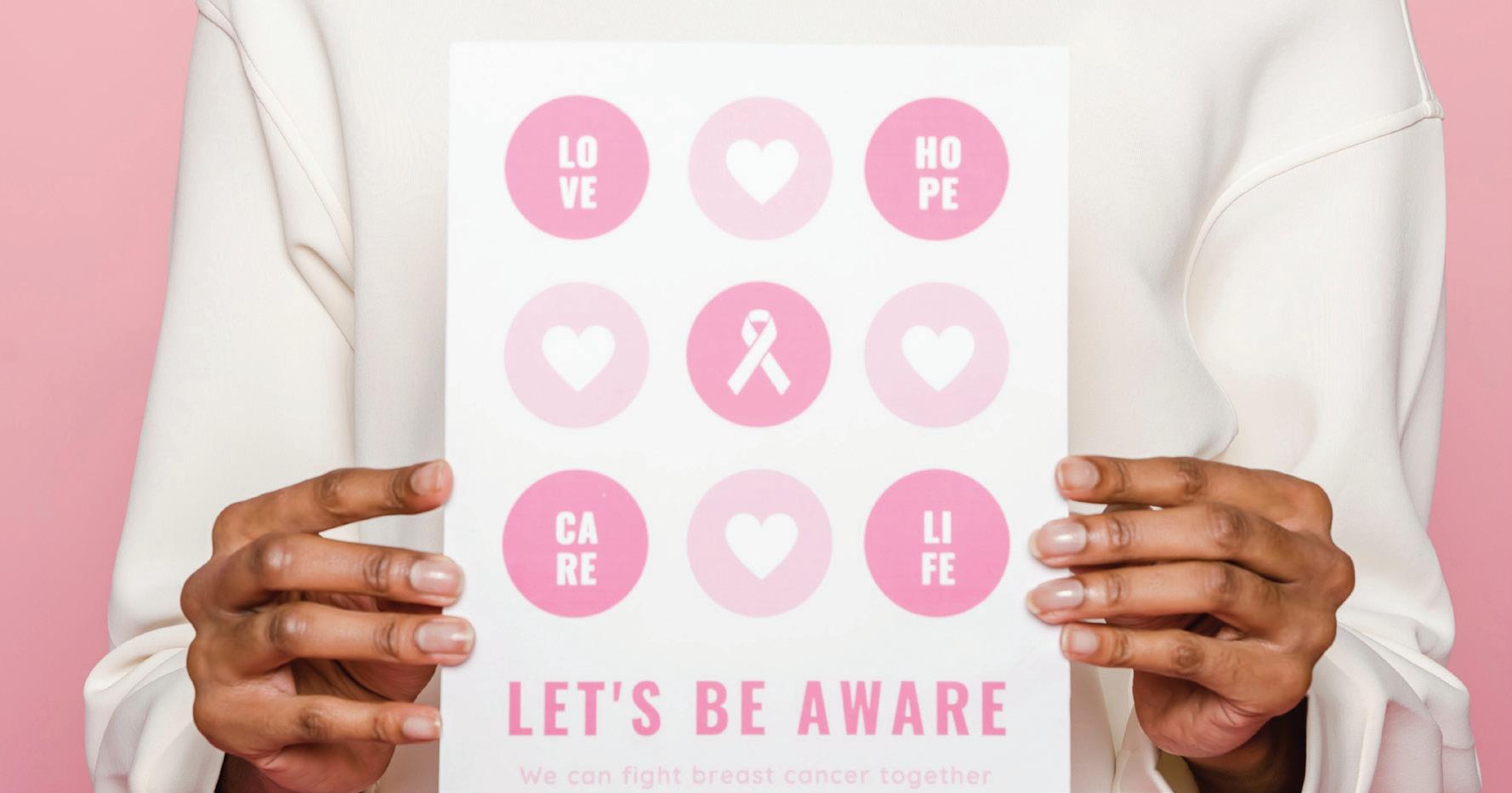
against this potentially deadly, yet treatable disease.
The American Cancer Society urges women to take note of how their breasts normally look and feel. That knowledge is vital because it helps women recognize when something does not look or feel good to the touch with their breasts. Screening alone may not be sufficient, as the ACS notes that mammograms do not find every breast cancer.
When women are well acquainted with how their breasts look and feel, they’re in better
position to recognize any abnormalities, which may or may not be indicative of breast cancer. The ACS reports that the following are some potential warning signs of breast cancer.

• A new lump or mass: The ACS indicates that this is the most common symptom of breast cancer. A lump or mass that is cancerous is often painless, but hard and has irregular edges. However, lumps caused by breast cancer also can be soft, round and tender. Some even cause pain.
• Swelling: Some women experience swelling of all or part of a breast even if they don’t detect a lump.
• Dimpling: The skin on the breast may dimple. When this occurs, the skin on the breast sometimes mimics the look of an orange peel.
• Pain: Pain on the breast or nipple could indicate breast cancer.
• Retraction: Some women with breast cancer experience retraction, which occurs when the nipple turns inward.
• Skin abnormalities: Breast cancer may cause the skin on the breast to redden, dry out, flake, or thicken.
• Swollen lymph nodes: Some women with breast cancer experience swelling of the lymph nodes under the arm or near the collarbone.
The presence of any of these symptoms merits a trip to the doctor. Women with these symptoms should not immediately assume they have breast can cer, as the ACS notes that various symptoms of breast cancer also are indicative of non-cancerous conditions that affect the breasts. Only a physician can diagnose breast cancer, which underscores the importance of reporting symptoms to a doctor immediately.
Many women are concerned about the potential for developing breast cancer in their lifetimes. Breast cancer is the secondmost common cancer among women in the United States and Canada. Despite that preva lence, there are ways for women to reduce their risk for breast cancer.

While it is impossible to change family his tory or genetic markers like gene mutations that increase breast cancer risk, the following are seven ways women can lower their risk.
1 Exercise regularly and maintain a healthy weight. Physical activity and monitoring calories can keep weight in check. The Mayo Clinic recom mends at least 150 minutes per week of moderate aerobic activity or 75 minutes per week of vigorous aerobic activity. Strength training at least twice a week also is recommended. Being overweight or obese increases a woman’s risk for breast cancer.
2
Consume a healthy diet. The link between diet and breast cancer risk is still being studied. How ever, research suggests that a diet high in vegetables and fruit, and calcium-rich dairy products, but low in red and processed meats may lower breast cancer risk.
Avoid or limit alcohol consumptions. Alcohol increases risk of breast cancer, even in small amounts. For those who drink, no more than one alcoholic drink a day should be the limit. The more a woman drinks, the greater her risk of developing breast cancer, states the Mayo Clinic.
Undergo genetic counseling and testing. Women concerned about a genetic connection or family history of breast cancer can speak to their doctor about testing and counsel ing that could help them reduce their risk. Preventive medicines and surgeries might help those at elevated risk for breast cancer.
Limit hormone therapy. Combination hormone replacement therapy for post-menopausal women may increase risk of breast cancer, indicates the Centers for Disease Control and Prevention. Similarly, taking oral contraceptives during reproductive years may increase risk. Women can speak with their physicians to weigh the pros and cons of taking such hormones.
Breastfeed children, if possible. Breastfeeding has been linked to reducing a woman’s risk of developing breast cancer.
Learn to detect breast cancer. Women should get to know their bodies so they can determine if something is awry as early as possible. Early detection of breast cancer increases the chances that treatment will prove successful.
Women can embrace various strategies to reduce their risk of developing breast cancer.
Millions of women worldwide are diagnosed with breast cancer each year. Such a diagnosis is never welcome, but women should know that survival rates have improved dramatically in recent decades. In fact, the World Health Organization reports that, by the end of 2020, nearly eight million women were living despite having been diagnosed with breast cancer at some point in the pre vious half decade.
One of the reasons for the improved survival rates is the ef ficacy of various treatments. The National Breast Cancer Foundation, Inc.® notes that doctors have various options to treat breast cancer, and they often devise treatment plans that include some combination of treatments. Though no one wants to imagine receiving a breast cancer diagnosis, understanding the potential treatments for the disease can help women and their families be more prepared should that day ever arrive. The following are three treatment options physicians may discuss with women as they begin devising ways to overcome the disease.
Chemotherapy is used to treat various cancers, includ ing breast cancer. Chemotherapy employs various drugs to destroy cancer cells or slow their growth. The drugs administered during chemotherapy are known as cytotoxic drugs and may be adminis tered orally or intravenously. The NBCF notes that chemotherapy is offered to most patients, though doctors will consider a host of variables before deciding if chemotherapy is right for a given
patient. Those variables include the type of tumor, its grade and its size.
During radiation treatments, high energy rays are used to kill cancer cells. Only cells in the part of the body that is being treated with radiation are affected, so patients needn’t worry that other parts of their body will be hit with radiation. The NBCF reports that patients diagnosed with Stage 0 (DCIS) and most di agnosed with Stage 1 invasive cancer or higher can expect doctors to prescribe radiation therapy. Women who have had a lumpec tomy also are likely to be prescribed radiation. Two main kinds of radiation are generally considered for breast cancer patients. Exter nal beam breast cancer radiation treatment delivers cancer-killing rays through a large machine. Internal breast cancer radiation is a newer treatment that injects radioactive cancer-killing treatments into the affected area.
The NBCF reports that targeted therapy is commonly used in combination with traditional chemotherapy. Targeted therapy attacks specific breast cancer cells without harming normal cells, which is why it tends to produce less severe side effects than chemotherapy treatments. Targeted therapy employs drugs to block the growth of cancer cells in very specific ways. One example cited by the NBCF is the drug Trastuzumab, or Herceptin®, which is given to women whose breast tumors have too much of the abnormal protein HER2. Though the side ef fects of targeted therapies tend to be less severe, women may still experience issues like fever and chills, nausea, headaches, and other symptoms after drugs have been administered.
Expanding breast cancer treatments have done much to im prove survival rates for patients. Women diagnosed with the disease are urged to play an active role in their treatments and ask any questions they might have before, during and after being treated.
Efforts to educate women about breast cancer have helped raise awareness of the disease and just how treatable it is when detected early. De spite that, a diagnosis can still be difficult for women and their families. When someone close to you is affected by breast cancer, priorities suddenly change and you may be won dering what you can do to provide the support needed to help this person navigate any ups and downs that could be on the horizon.
A breast cancer diagnosis does not produce a uniform response. While one loved one may embrace others wanting to help, another may feel she is a burden and exhibit an unwillingness to accept help. In the latter instance, being a supportive bystander may require walking on eggshells. Even still, there are some universal ways to lend support when a friend or a loved one has been diagnosed with cancer.
• Offer practical support. Cancer affects the body in a number of ways. Energy levels may wane and certain symptoms may arise. Side effects from treatments also can make it difficult to continue with daily tasks. So an offer to help with tasks associated with daily living, such as cooking meals, gardening, washing clothes, or cleaning up around the house, can
be practical and much appreciated. Approach the individual and ask questions in pointed ways. Rather than, “What can I do to help?”, which may result in an answer of, “Nothing,” figure out a way to pitch in and then ask if that would be acceptable. This may be, “Would you like me to run to the supermarket for you today?”
• Offer emotional support. Someone with breast cancer may just need a person who can be there and listen. A hug, a nod of understanding or even a companion who can chat and take the per son’s mind off the cancer can be immensely helpful. Keep in mind that emotions may change on a dime, and some emotions may be directed at support systems. While it can feel hurtful, remember the real reason for any outburst is the disease. Patience is needed at all times.
• Learn what you can about breast cancer. Research the type of cancer your loved one has, which may make it easier to understand what to expect. If the person is amenable, you may consider accompanying her to appointments to hear firsthand about the next steps in her treatment and recovery.
• Maintain a positive attitude. It’s never easy know ing someone you love is sick. They are going through their own emotional roller coaster, and support systems can lift their spirits by maintaining positive attitudes. Avoid wearing rose-colored glasses, but try to remain as upbeat as possible.
• Find a support group. Professional support groups are great resources for coping with a cancer journey. Supporting a per son with cancer takes its own unique toll, particularly when caring for a spouse, child or mother with breast cancer. Support groups for support networks can be helpful.

Individuals diagnosed with breast cancer may need a little extra love and support. It’s up to caregivers and friends to step up and provide what is needed.

Cancer is an insidious disease that affects just about every part of the body, including the breasts. The World Cancer Re search Fund International indicates there were more than 2.26 million new cases of breast cancer in women in 2020.
Women understandably want to learn what they can do to reduce their risk of developing breast cancer. One of the first considerations may be analyzing diet and determining if it is affecting breast cancer risk.
A variety of factors affect a woman’s risk for developing breast cancer, and certain lifestyle choices, including diet, can play a role. However, according to Healthline, the risk factors with the biggest impact include sex, age and genetics. Lifestyle can influence breast cancer risk but not at the same levels as genetic markers, family history, gender, or age. However, women interested in doing all they can to stay healthy may want to take a closer look at the foods and beverages that can adversely affect breast cancer risk.
Healthy food choices are linked to lower incidences of can cer and other conditions. Susan G. Komen states that eating plenty of fruits and vegetables may be linked to a lower risk of developing breast cancer. A pooled analysis of data from 20 studies found women who ate the most vegetables had a lower risk of estrogen receptor-negative breast cancer (but not estrogen receptor-positive breast cancer) compared to women who ate the least vegetables, according to a 2013 report published in the Journal of the National Cancer Institute. And it doesn’t really matter if produce is organic or not. According to the
American Cancer Society, the benefits of eating fresh fruits and vegetables outweigh any health risks linked to pesticide residue.
The complex relationship between fat, sugar and cancer
Though a single food will not lead to higher breast cancer risk, overeating and putting on excess weight can increase risk. That is why it is essential to get plenty of exercise each week and monitor calorie consumption. While women who are in their reproductive years may not see as much breast cancer risk from being overweight or obese, after menopause, that risk increases, says Susan G. Komen. The risk is not directly related to fatty foods, however. The American Cancer Society says an examination of the amount of fat eaten by women in the United States found no link between fat and breast cancer risk.
In addition, while consuming too much sugar may not be healthy in the long run, it’s a myth that “sugar feeds cancer.” Eating sugar may lead to weight gain, which may increase the risk of breast cancer, says the ACS.
One component of diet that has been studied extensively is the effects of alcoholic beverages on breast cancer risk. Susan G. Komen reports that a pooled analysis of data from 53 stud ies found women who had two to three alcoholic drinks per day had a 20 percent higher risk of breast cancer compared to those who didn’t drink alcohol. Alcohol should be limited to one drink per day for the average woman, or none at all, if possible.
Diet is only one factor in the risk for developing breast cancer. While important, there are other components that increase risk by a more significant margin.









